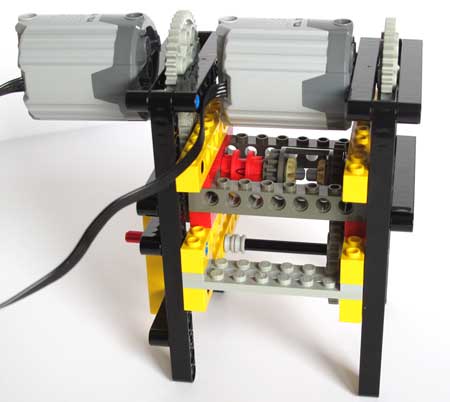![]()
![]()
![]()
![]()

Coupling motors
A question is often asked on LEGO forums: is it possible
to couple motors to get more power? And if so, is it better
to use direct coupling, or to use a differential based adder?
As I was already in a motors testing campaign, I built the above
contraption, allowing to couple two motors either directly or
through an adder. Switching between the two modes is done by
sliding the driving ring. Gearing and friction is the same in
both modes (except for the differential gears not used in locked
mode of course!), so comparison makes sense. We measure rotation
speed of the composite motor (which is proportional to delivered
mechanical power) under various torque (weight lifting).
|
Torque |
Speed
(rpm) |
Speed
(rpm) |
Difference (%) |
PF Medium |
2.56 |
328.3 |
328.9 |
0.18 |
6.40 |
239.9 |
238.3 |
-0.66 |
|
11.5 |
125.5 |
123.8 |
-1.34 |
|
PF Large |
2.56 |
315.8 |
314.5 |
-0.42 |
6.40 |
258.8 |
258.5 |
-0.12 |
|
11.5 |
184.3 |
185.0 |
0.33 |
|
PF XL |
2.56 |
197.1 |
198.2 |
0.54 |
6.40 |
184.1 |
184.3 |
0.10 |
|
11.5 |
165.8 |
168.8 |
0.60 |
As you can see, there is essentially no performance
difference between coupling methods... Of course this is meaningful
for identical motors!
The test results showing available mechanical power of coupled motors are here.
![]()

![]()
![]()
![]()
